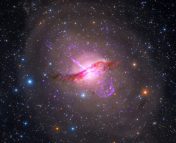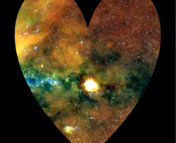Title: A new discovery space opened by eROSITA: Ionised AGN outflows from X-ray selected samples
Authors: Blessing Musiimenta, Marcella Brusa, Teng Liu, Mara Salvato, Johannes Buchner, Zsofi Igo, Sophia G. H. Waddell, Yoshiki Toba, Riccardo Arcodia, Johan Comparat, David M. Alexander, Francesco Shankar, Andrea Lapi, Cristina Ramos Almeida, Antonis Georgakakis, Andrea Merloni, Tanya Urrutia, Junyao Li, Yuichi Terashima, Yue Shen, Qiaoya Wu, Tom Dwelly, Kirpal Nandra, Julien Wolf
First Author’s Institution: Dipartimento di Fisica e Astronomia ’Augusto Righi’, Alma Mater Studiorum – Università di Bologna, Italy
Status: Accepted to A&A [open access]
Searching for ‘blow-outs’
Almost every galaxy in the universe has a Supermassive Black Hole (SMBH) at its centre. These SMBHs are responsible for some truly fascinating phenomena – most notably, Active Galactic Nuclei (AGN) – enormous eruptions of light and energy that result in the brightest objects known. These massively energetic events also have significant effects on the galaxies surrounding the SMBHs. But what happens when a previously-quiet SMBH turns on? While never observed, it’s thought that the AGN spits all the gas and dust in its surroundings into its host galaxy in a quick, violent move known as the ‘blow-out’ phase of an AGN. The delicate star-forming structures in the galaxy can’t survive this sudden influx of energy, and star formation in the galaxy shuts off, possibly for good.
Theorists are now fairly certain that this blow-out phase must exist. In fact, galaxy simulations over the past few decades have shown that it’s necessary to invoke feedback (the shutting-down of star formation) from AGN to get simulated galaxies to behave anything like the galaxies we see in real life. What is more difficult, however, is actually observing blow-out AGN in action, and thus determining what effects they’ll have on the galaxies surrounding them. An AGN in its first stages of blow-out will have ionised gas moving away from the AGN very quickly (known as an outflow). It’s proven surprisingly difficult to gather a large sample of these objects in order to do statistics, probably in part because the blow-out phase happens so fast (at least, on astronomical timescales). In today’s paper, the authors aim to gather a sample of blow-out AGN, to study their properties conclusively.
eROSITA and eFEDS
The authors of today’s paper are studying AGN using data from eROSITA, an X-ray telescope aboard the Russian-German space mission Spectrum-Roentgen-Gamma. In particular, they’re looking at data from a 140-square-degree patch of the sky known as eFEDS, which is targeting X-ray sources outside of our own Milky Way galaxy (see Figure 1). The eFEDS survey ran for only four days during the testing and commissioning of eROSITA, but still found more than 27000 X-ray sources. Each of these sources also had catalogued information about their brightness in many other photometric bands across a wide range of the electromagnetic spectrum.
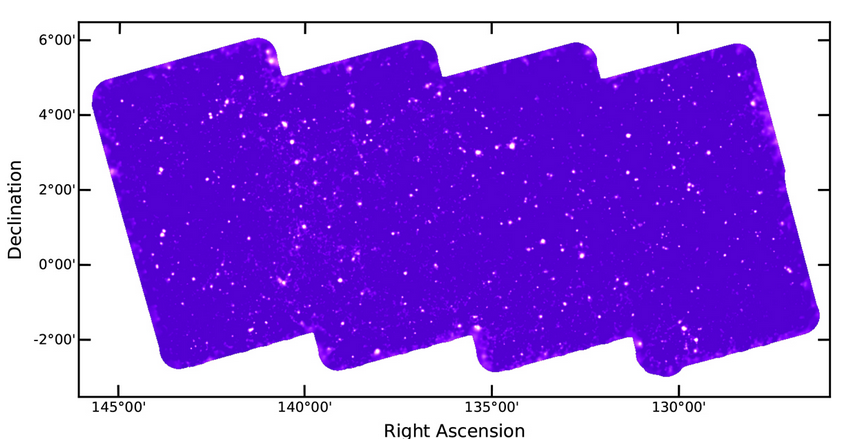
The first part of the author’s job, then, was to narrow this enormous survey down to only X-ray sources that might conceivably be outflowing AGN. This is difficult, because the characteristics of this population aren’t entirely clear. What the authors ended up doing was combining five different selection techniques to come up with their final sample. The first four techniques were based on the ‘colour’ of the X-ray sources – how much light appeared for each source in specific filters targeting optical and infrared light. Specific values of the differences between these bands have been shown in other surveys to indicate enhanced dust, which may suggest that the AGN is in its blowout phase. The authors combined these selection criteria with others based on the ratio of X-ray flux to optical flux to establish the first four selection criteria.
For the last criterion, the authors used a known AGN trick – a relationship between the column density (the amount of material the light encounters as it travels from the AGN to the telescope) and the Eddington ratio (the ratio between the amount of gravity pulling matter onto the black hole and the amount of force from the light pushing that material away) of each source. Because they were expecting blow-out AGN to appear in different ways, they kept any source that passed even just one of the tests. Overall, they found 1376 unique X-ray sources that, based on these tests, could plausibly be an outflowing AGN.
Looking for Outflows
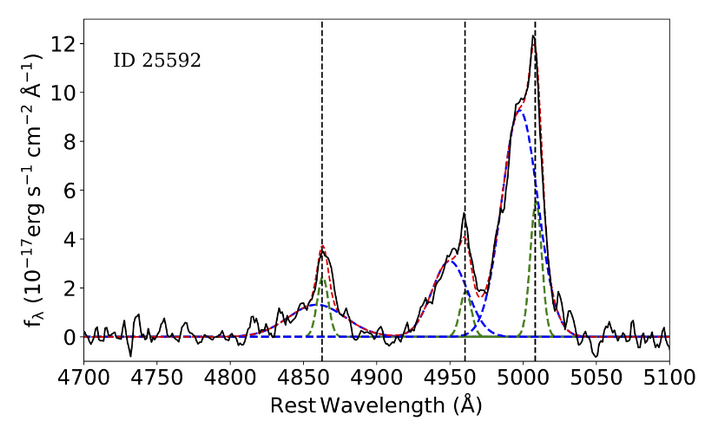
Once the authors assembled a sample of AGN potentially in their blow-out phase, they had to make sure that they were actually undergoing this ‘blow-out’ – they had to find signatures of gas outflowing from the AGN. To do this formally requires spectroscopic observations of specific emission lines (the authors used [OIII]). Unfortunately, these observations were fairly limited for the eFEDS sample – only 50 of the 1376 observations had good-quality observations of the [OIII] line (all from SDSS, the Sloan Digital Sky Survey). Of the 50 objects that had spectra, 23 objects (45%) showed clear signatures of an outflow. An example of a spectrum with an outflow signature is shown in Figure 2 – note that the [OIII] lines have both a broad (the blue dashed line) and a narrow (the green dashed line) emission component.
The Power of Outflows
Once outflows are discovered, the next big question is: do they matter? Essentially, the authors try to see if the amount of energy being put into the galaxy from the outflow is enough to shut down the formation of new stars in the galaxy – in astronomical terms, if the energy is enough to ‘quench’ the galaxy. They do this by comparing the amount of energy injected into the galaxy by the outflow every year (the ‘kinetic power’ of the outflow) to the amount of energy the galaxy is emitting as light across all wavelengths (its ‘bolometric luminosity’). Theorists have suggested that if the kinetic power is equal to at least 1% of the bolometric luminosity, the outflow is almost certainly having a significant effect on the galaxy as a whole. This, however, is most likely a lower limit, as the outflows traced by [OIII] are only looking at a specific phase of the gas (the ionised phase), and it’s possible that comparable amounts of gas in other phases are outflowing from the AGN, and thus injecting comparable amounts of energy.
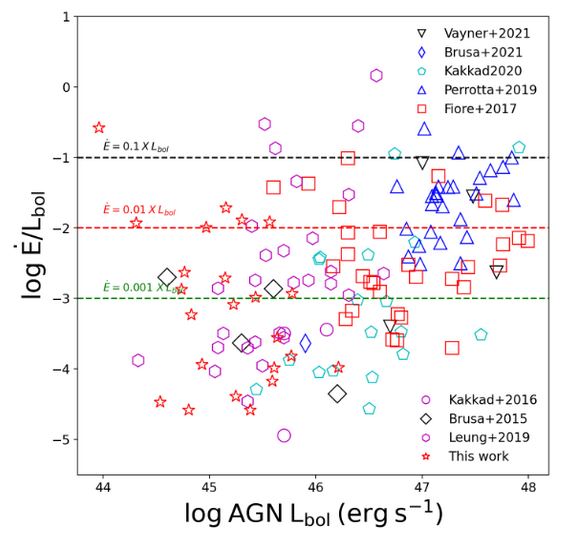
The eFEDS sample of 23 isn’t a particularly large sample for doing statistics, so the authors combined it with a sample of 118 outflowing AGN that had been discovered in other surveys. The ratio between the kinetic power and bolometric luminosity of all of these galaxies is shown in Figure 3. 30% of the galaxies in the full sample have ratios greater than 1%, and, since this is likely a lower limit, the authors take this as evidence that these outflows will have significant effects on their host galaxies.
Next Steps for Outflows
It is very important for our understanding of what shuts star formation down in galaxies to actually track down the galaxies that are having those processes happen, and that’s what the authors of today’s paper did. They used an exciting new X-ray sample from eROSITA to identify potential AGN in their blowout phase (ie, with outflows). Assuming that the galaxies with SDSS spectra are an accurate representation of the rest of the sample, they found that roughly 45% of the sample they assembled do indeed have outflows. It’s not a given that this spectroscopic sample is an accurate representation, however, so one next step is to obtain spectra for a larger sample of these potential outflowing AGN. The authors additionally found that it’s likely the AGN with outflows are significantly impacting their host galaxies, suggesting that they have actually observed AGN feedback as it happens! While the details still need to be nailed down, it’s very exciting to keep building our sample of these objects, and digging deeper into the many factors that affect star formation in galaxies.
Astrobite edited by Mark Popinchalk
Featured image credit: ESO/M. Kornmesser

